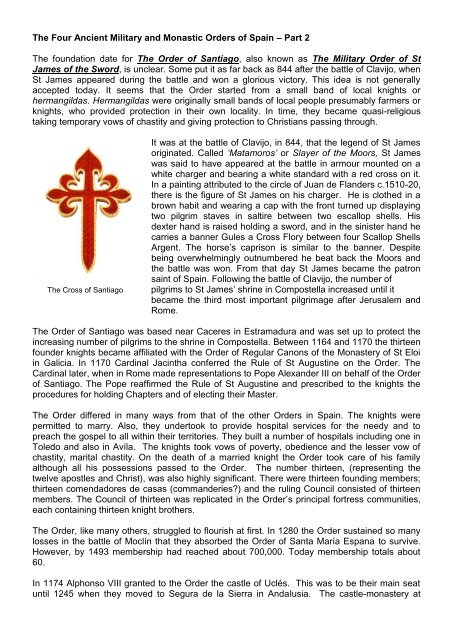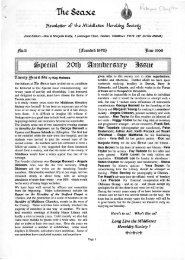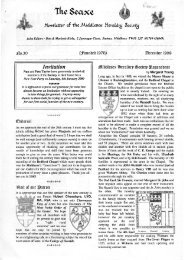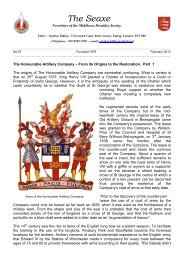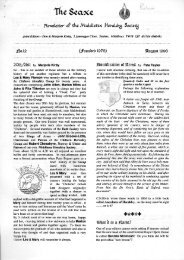The Seaxe - Middlesex Heraldry Society
The Seaxe - Middlesex Heraldry Society
The Seaxe - Middlesex Heraldry Society
Create successful ePaper yourself
Turn your PDF publications into a flip-book with our unique Google optimized e-Paper software.
<strong>The</strong> Four Ancient Military and Monastic Orders of Spain – Part 2<br />
<strong>The</strong> foundation date for <strong>The</strong> Order of Santiago, also known as <strong>The</strong> Military Order of St<br />
James of the Sword, is unclear. Some put it as far back as 844 after the battle of Clavijo, when<br />
St James appeared during the battle and won a glorious victory. This idea is not generally<br />
accepted today. It seems that the Order started from a small band of local knights or<br />
hermangildas. Hermangildas were originally small bands of local people presumably farmers or<br />
knights, who provided protection in their own locality. In time, they became quasi-religious<br />
taking temporary vows of chastity and giving protection to Christians passing through.<br />
It was at the battle of Clavijo, in 844, that the legend of St James<br />
originated. Called ‘Matamoros’ or Slayer of the Moors, St James<br />
was said to have appeared at the battle in armour mounted on a<br />
white charger and bearing a white standard with a red cross on it.<br />
In a painting attributed to the circle of Juan de Flanders c.1510-20,<br />
there is the figure of St James on his charger. He is clothed in a<br />
brown habit and wearing a cap with the front turned up displaying<br />
two pilgrim staves in saltire between two escallop shells. His<br />
dexter hand is raised holding a sword, and in the sinister hand he<br />
carries a banner Gules a Cross Flory between four Scallop Shells<br />
Argent. <strong>The</strong> horse‟s caprison is similar to the banner. Despite<br />
being overwhelmingly outnumbered he beat back the Moors and<br />
the battle was won. From that day St James became the patron<br />
saint of Spain. Following the battle of Clavijo, the number of<br />
<strong>The</strong> Cross of Santiago pilgrims to St James‟ shrine in Compostella increased until it<br />
became the third most important pilgrimage after Jerusalem and<br />
Rome.<br />
<strong>The</strong> Order of Santiago was based near Caceres in Estramadura and was set up to protect the<br />
increasing number of pilgrims to the shrine in Compostella. Between 1164 and 1170 the thirteen<br />
founder knights became affiliated with the Order of Regular Canons of the Monastery of St Eloi<br />
in Galicia. In 1170 Cardinal Jacintha conferred the Rule of St Augustine on the Order. <strong>The</strong><br />
Cardinal later, when in Rome made representations to Pope Alexander III on behalf of the Order<br />
of Santiago. <strong>The</strong> Pope reaffirmed the Rule of St Augustine and prescribed to the knights the<br />
procedures for holding Chapters and of electing their Master.<br />
<strong>The</strong> Order differed in many ways from that of the other Orders in Spain. <strong>The</strong> knights were<br />
permitted to marry. Also, they undertook to provide hospital services for the needy and to<br />
preach the gospel to all within their territories. <strong>The</strong>y built a number of hospitals including one in<br />
Toledo and also in Avíla. <strong>The</strong> knights took vows of poverty, obedience and the lesser vow of<br />
chastity, marital chastity. On the death of a married knight the Order took care of his family<br />
although all his possessions passed to the Order. <strong>The</strong> number thirteen, (representing the<br />
twelve apostles and Christ), was also highly significant. <strong>The</strong>re were thirteen founding members;<br />
thirteen comendadores de casas (commanderies?) and the ruling Council consisted of thirteen<br />
members. <strong>The</strong> Council of thirteen was replicated in the Order‟s principal fortress communities,<br />
each containing thirteen knight brothers.<br />
<strong>The</strong> Order, like many others, struggled to flourish at first. In 1280 the Order sustained so many<br />
losses in the battle of Moclín that they absorbed the Order of Santa María Espana to survive.<br />
However, by 1493 membership had reached about 700,000. Today membership totals about<br />
60.<br />
In 1174 Alphonso VIII granted to the Order the castle of Uclés. This was to be their main seat<br />
until 1245 when they moved to Segura de la Sierra in Andalusia. <strong>The</strong> castle-monastery at


